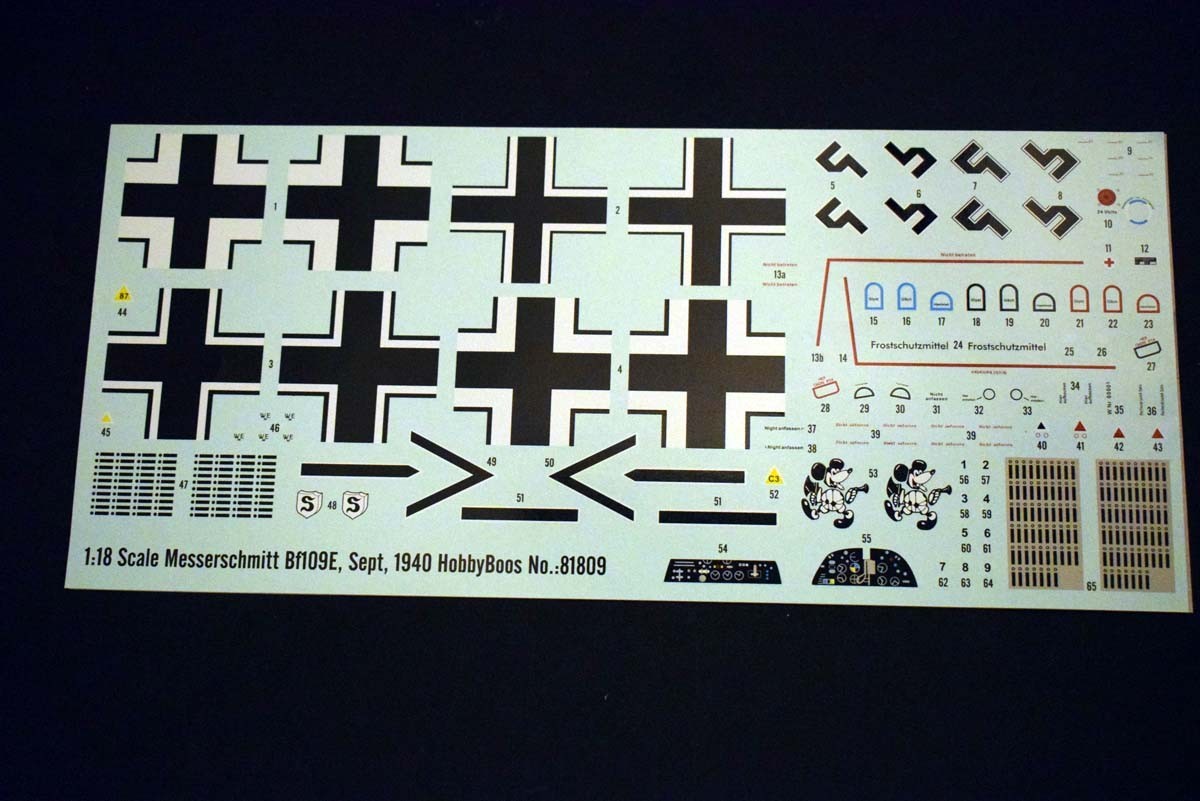
Introduction
The Messerschmitt Bf 109 saw service in the Luftwaffe throughout World War II, and before that in the Spanish Civil War. The early Bf109 proved itself against Russian aircraft, being used by the other side during the Spanish Civil War. During World War II, it held its own for a good period of the war, until it started to be outclassed by later marks of Spitfire, the Mosquito and Mustang. That said it remained a capable aircraft. The E version supplied here, does not provide a number with it, period wise I would guess early, and so it service during the early period of the war and I believe even saw service in North Africa.
Review
This offering from Hobby Boss of a 1/18th scale Messerschmitt Bf109E, is supplied in a substantial cardboard box that should protect it and the individually packaged sprues further help. A quick look at the mouldings of what is listed as a new moulding, reminds me very much of the aircraft offerings from another company with kits released in this scale. As far as the mouldings go, I have no major concerns reference the seen areas of the model, but the recessed panel lines are large and deep. The biggest issue is likely to be the huge size of the gates between parts and sprue. First impressions of the model are is that this release is aimed squarely at children coming into the hobby, or for drawing children into the hobby, due to its large scale and low parts count.
The model offers a simple cockpit tub, which has potential for a starting point but would require a lot of work to bring it up to a standard suitable for those modellers that like their details to pop. To give you an idea of how simple this model is, the entire cockpit including the instrument panel has a total of 10 pieces. The two fuselage halves are quickly closed up around the cockpit tub, and screw together with plastic caps supplied to go over the recessed screw holes, and so by the end of stage two you have a reasonably complete fuselage that includes the horizontal tail surfaces and their support struts. An interesting aspect of this release, is that you are provided with vinyl rubber tyres with moulded plastic hubs, and in the case of the tail wheel a metal axle.
The prop of the aircraft is supplied as a single piece spinner, with the centre covered by two pieces front and rear to make up the propeller boss. The propeller is designed to rotate, via the usual method of a plastic piece inside the engine area to the centre of the propeller boss. The engine bay cover, is a single moulding with two parts to replicate the machine guns at the top. The canopy of the model, is provided in three pieces but is not designed to be displayed open.
The wings of the model are provided via a full span lower wing with two half upper wings. The flight controls are provided separately, but these are not movable. As with the tail wheel, the wheels are provided with plastic inners and vinyl rubber tyres and are designed to be screwed to the undercarriage leg, which has been moulded with the wheel bay doors in place. The legs of the undercarriage are not glued in place, but are designed to be deployable via a method used by Airfix back in the 70’s on their 1/24th scale kits. The wheel struts are prevented from coming loose via two panels screwed into place on the lower wing. The wing is then attached to the fuselage, again with a screw - this time the hole being hidden by an external fuel tank and its mount. That is assembly finished in six stages.
A single finishing option is provided with this release, although no aircraft identification in included, but surprisingly they do provide swastikas for the tail. The painting option does provide the visually pleasing yellow nose and tail which does make this stand out. However, I question the painting instructions for the underside of the aircraft as a grey colour is indicated, although it states that it is light blue, and all of the Bf109’s of this period that I am aware of have an almost sky blue underside.
Conclusion
The release from Hobby Boss in 1/18th scale, would make for a brilliant introduction to the hobby for a child. It is big, easily assembled and depending on painting ability a colourful model that could be visually pleasing. Detail is simplistic to say the least, and it is that aspect that will deter serious modellers from engaging with it. Despite the larger mouldings being held together with screws, I would still use plastic cement on this model. So in closing an excellent model for the youngster starting in the hobby or already in the hobby, but not one for the serious modeller unless willing to engage in a lot of extra work.












































